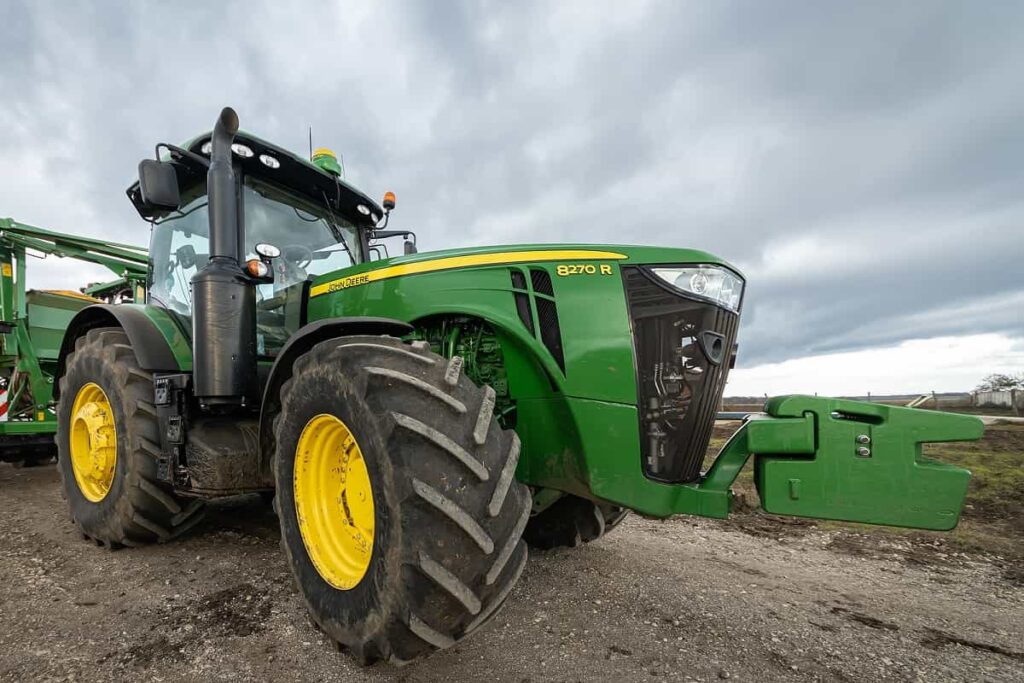14 Agricultural Robots Making Farming Easier
Table of contents

It’s a real shame that many media outlets are now removing the ability for their readers to comment. It’s often in the comments where you’ll find some of the more interesting stuff. Our recent article on How Fruit Packing Warehouses Use Technology surfaced a comment from a Canadian cherry grower who had the following to say about robots getting involved in producing fruit:
In all the talk about tireless, defect-free, never complaining robots, let’s remember that producing fruit is also about people in fruit-growing communities who need good jobs to pay for their lives and raise healthy kids. Let’s rein in our excitement about relentless automation.
Absolutely correct, but what we might visualize as “fruit-growing communities” vary by geography. The one we spent several weeks at in Bingen, Washington staffed Mexican workers because they’re the only ones who won’t quit halfway through the first day because they underestimated just how tough a job picking fruit is. Each worker probably supports multiple families back home with that income. If the Mexicans don’t show up around fruit picking time, good luck finding other people to do the work. For orchard operators, that’s a big risk. And to mitigate that risk, many will be turning to autonomous machines – agribots – for improving quality and efficiency of yield, minimizing reliance on manual labor, and increasing overall productivity.
Updates on Some Agribots
Let’s see what’s been happening with the 6 Agriculture Robot Startups for Farming we covered way back in 2017:
- Abundant Robotics (picks apples) – First commercial harvest this past March at T&G’s Hawkes Bay orchards in New Zealand.
- Vision Robotics (orange harvesting machine) – Appears to be pivoting into all kinds of other projects like lettuce thinning, crop load estimation, and grapevine pruning.
- Harvest Automation (moves potted plants in nurseries) – No news since 2016. Maybe they saw the great stuff Mr. Doust and his team are doing over at AIS and gave up.
- Naïo Technologies (robot for weeding vineyards) – According to their dreadful website, they’ve developed some new robots for weeding vegetables like lettuce.
- ecoRobotix (solar-powered weeding robot) – Lots of robots being tested in fields, raised $10.7 million more with participation from BASF.
- Soft Robotics (developing a polymer “gripper”) – Further products being developed and put to use in cobot applications.
Now, let’s look at some more agricultural robots that have come across our radar since the last time we looked at this space.
Robots in the Greenhouse


The autonomous vehicle is designed for seamless integration with existing greenhouse infrastructure. MetoMotion estimates a reduction of up to 50% in harvest-related labor costs, with a predicted ROI in under three years for the grower.
Picking Goose Berries
Robotics Plus first came across our radar in a piece we wrote earlier this year on 12 Smart Farming Companies Making Farmers Smarter in which we talked about their robotic apple packing machine which can carefully handle up to 120 pieces of fruit every minute. It’s just one of many projects they’re working on, one of which is a robot that can help pick the more than 3 billion kiwifruits harvested in New Zealand each year. (New Zealand produces 25% of the world’s kiwifruit – or gooseberries as the Chinese call them.) “Labor shortages and arrival of new varieties have made getting the fruit off the vine at the right time a huge challenge for growers,” said the NZ Herald back in 2017 which estimated the arrival of these robots by next year. Not a whole lot of information is available on their website about the progress the company is making, so we’re sending one of our MBAs over to the North Island to have a look. Stay tuned.
The Uber of Agribots


According to an article by AgFunderNews, TartanSense is targeting India’s largest crop, cotton, with an Uber-like model where a farmer will request a weeding service.
Organic Weed Removal
The only thing better than using 90% less herbicide is using no herbicide at all – which means you can slap on the organic label and charge twice as much. Founded in 2016, San Francisco startup FarmWise has taken in $20.2 million in funding so far to develop an 8,000-pound robot that can cleanly pick weeds without using any pesticides at all. It’s not just about pulling weeds. The company’s robots use computer vision to perceive a wide range of information about each plant. Each day, one of their robots can weed crops to feed a medium-sized city of approximately 400,000 inhabitants.

Their robots have already been deployed commercially having efficiently removed weeds from more than 10 million plants.
Roomba for Rock Picking


Each spring, farmers across the country prepare fields so they can use them to grow corn, soybeans, wheat, and other crops. The first part of this prep work is to plow the field and expose the underlying soil to the sun. The second part involves removing rocks that can rise up toward the surface due to factors such as freezing temperatures and soil-tilling and can damage crops and equipment if left unpicked. TerraClear says it’s developing an “automated agricultural implement” to clear rocks from fields. Based on how sophisticated the process appears to be, an “Uber for rock removal” business model may be in order.
Robotic Strawberry Harvesters
If you thought picking apples with robots was a challenge, just try strawberries. Our next three agricultural robots are all focused on capturing a piece of the $16 billion strawberry market.
Agrobot
There’s not a whole lot of info on their website, but Spanish startup Agrobot has taken in an undisclosed amount of funding to develop a fully automated strawberry harvester with 24 “arms” working independently to pick rows of strawberries at a time. If you’ve ever picked strawberries, you’ll know the feeling of constantly bending over plants for hours trying to find ripe enough strawberries to pick. Agrobot uses machine learning to gauge the ripeness of the berries first. In order to protect the berries from squeezing or falls, they are then cut from their stems by two thin, razor-sharp blades. Once cut, they’re immediately caught in a tiny basket lined with rubber rolls, which places the fruit on a conveyor belt leading to the packaging area. You can even choose how you want them picked (good luck getting humans to do that).

A CNBC article last year talked about how “one Agrobot could harvest around 20 acres in three days” and that around 69% of Californian farmers hiring seasonal help had “reported shortages of varying degrees.” Maybe that’s why the Californians aren’t waiting for the Spaniards to cross the pond.
Advanced Farm Technologies
Founded in 2017, Davis, California startup Advanced Farm Technologies (AFT) has taken in $9.2 million in funding so far to develop their T-6 robotic strawberry harvester with investors that include Yamaha and Kubota. Like Agrobot, the robot uses multiple robotic arms with custom grippers to harvest strawberries grown in soil. California is the largest strawberry producing state in the U.S., and that’s where AFT deployed their first strawberry-picking robot commercially which operates on farms in the Oxnard, Santa Maria, and Salinas-Watsonville areas of California. The company plans to develop other robots-as-a-service for farmers.
Harvest CROO
Founded in 2013, Florida startup Harvest CROO has taken in $3 million in funding to develop their own behemoth robot that picks strawberries and will soon pack them. In a past article on Creating Synthetic Data for Computer Vision Algorithms, we learned about how they’re training algorithms to gauge the ripeness of strawberries and using synthetic data to do it. The latest version of their agribot – Berry 5 – is expected to be harvesting strawberries in Florida when the next strawberry season starts late this year. That’s according to an article by The Packer which says the robot “can replace 25-30 workers on a three-day pick cycle of a 25-acre field.”

Conclusion
If we’re going to feed the billions of mouths coming online over the next decade, we’ll need technology to do it. Agricultural robots don’t just help address labor shortages for farmers, they also help improve those ESG scores. A company called Blue River Technologies developed a robot that cruises through rows of lettuce doing drive-bys on weeds by zapping them directly with herbicide. The end result is a 90% reduction in herbicide use, something that was so appealing that the “LettuceBot” managed to capture 10% of the entire lettuce market before John Deere (DE) acquired them for $305 million. While some jobs will be impacted by robots, hopefully, those individuals can move on to more value-added activities and provide their families with an even better life.
Sign up to our newsletter to get more of our great research delivered straight to your inbox!
Nanalyze Weekly includes useful insights written by our team of underpaid MBAs, research on new disruptive technology stocks flying under the radar, and summaries of our recent research. Always 100% free.














